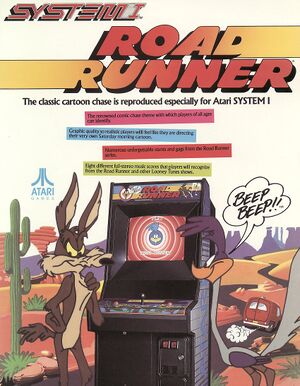Road Runner (video game)
- This article is about the video game. For the character of the same name, see the Road Runner.
| Road Runner (video game) | |
|---|---|
 Arcade flyer. | |
| Publisher | Atari Games Beam Software (NES) |
| Developer | Atari Games Atari Corporation (2600) Tengen (NES) US Gold (ST) |
| Console | Arcade Amstrad CPC Atari 2600 Atari ST Commodore 64 DOS ZX Spectrum Nintendo Entertainment System |
| Genre | Racing |
| Release date | 1985 (Arcade) 1989 (2600, NES) |
Road Runner is a racing game developed by Atari Games, based on the Wile E. Coyote and Road Runner cartoons of the Looney Tunes/Merrie Melodies series. It was released on arcades in 1985.
Gameplay
The player must control Road Runner and elude Wile E. Coyote as he's chasing him. To stay ahead of the Coyote, the Road Runner must eat seeds to keep his speed meter up and running. Wile E. will instantly catch the Road Runner when the speed meter runs out.
In different points of the game, Wile E. will use various methods to try and catch the Road Runner:
- Rocket-powerd roller skates: Whenever Wile E. goes off-screen, he will speed up using his rocket-powered roller skates.
- Giant skyrocket: Wile E. will zoom back and forth on his rocket. It can be avoided before traversing onward on the road.
- Bed spring: Wile E. will bounce all over the screen using his bedsprings.
- Cannons: Wile E. has placed several cannon on the desert. The Road Runner can jump over the cannonballs to avoid them and let them hit Wile E. instead.
- Heli-pack and dynamite: Wile E. will take to the skies with his Heli-Pack and drop sticks of dynamite. The dynamite will instead shake Wile E. if avoided.
- Land mines: Later in the game, Wile E. will place landmines all over the road. They can be jumped over and let Wile E. run into his own trap.
- Iron bird seed and magnet: Wile E. will place fake iron bird seeds on the road. Should the Road Runner eat them, he will slow down and Wile E. can zoom on him with a magnet.
- Jet-propelled running shoes: Sometimes, Wile E. will run using his jet-propelled running shoes.
- Invisible paint: Sometimes Wile E. will sneak up on the Road Runner if he uses the invisble paint first. If the player uses it before he does, the Road Runner will become invisible for a short time.
In one part of the game, the player will come across rock avalanches, cliffs and oncoming trucks. Wile E. will tend to be run over, squished or tricked off the cliffs if the player was lucky enough to outpace him.
Characters
In order of appearance: | ||||||||||
| ||||||||||
Both the Road Runner and Wile E. Coyote get different Latin names every time the game starts:
| Road Runner | Wile E. Coyote |
|---|---|
| Velocitus delectibus | Hardheadus hungrus |
| Cantus stopus | Hard-headipus oepipus |
| Movoutus unbelivabus | Notso supersonicus |
| Hotus rodicus | Hungrii flea-bagius |
| Foreverus seedeatus | Overconfidenti vulgaris |
| Veryus quickus | Eatus roadrunnus |
| Acceleratii inredibilii | Pigoutus onbirdus |
| Disappearus quickus | Appetitus giganticus |
Development
Music
The background music was composed by Hal Canon and Earl Vickers for the arcade version. It primarily contains arrangements of classical music in most versions, including the arcade release:
- "William Tell Overture" by Gioachino Rossini (first level)
- "Flight of the Bumblebee" by Nikolai Rimsky-Korsakov (second level)
- "Trepak" from The Nutcracker by Pyotr Ilyich Tchaikovsky (third level)
- "Sabre Dance" from Gayane by Aram Khachaturian (fourth level; attract mode in the arcade version)
For the game over screen, a rendition "Merrily We Roll Along" is played in the background.
In the Atari 2600 port, a version of "The Merry-Go-Round Broke Down" plays at the title screen, and also for the start of a level or the game over screen.
In the NES version, "The Merry-Go-Round Broke Down" is used at the game over screen instead of "Merrily We Roll Along".